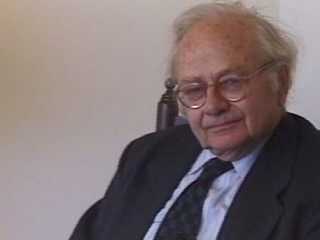
David H. Hubel biography
Date of birth : 1926-02-27
Date of death : -
Birthplace : Windsor, Ontario, Canada
Nationality : Canadian
Category : Science and Technology
Last modified : 2011-12-20
Credited as : neurobiologist, development of the visual system, Nobel laureate
1 votes so far
The Hubel and Wiesel experiments greatly expanded the scientific knowledge of sensory processing. In one experiment, done in 1959, they inserted a microelectrode into the primary visual cortex of an anesthetized cat. They then projected patterns of light and dark on a screen in front of the cat. They found that some neurons fired rapidly when presented with lines at one angle, while others responded best to another angle. Some of these neurons responded differently to light patterns than to dark patterns. Hubel and Wiesel called these neurons simple cells."
Still other neurons, which they termed complex cells, detected edges regardless of where they were placed in the receptive field of the neuron and could preferentially detect motion in certain directions.These studies showed how the visual system constructs complex representations of visual information from simple stimulus features.
Hubel and Wiesel received the Nobel Prize for two major contributions: 1. their work on development of the visual system, which involved a description of ocular dominance columns in the 1960s and 1970s; and 2. their work establishing a foundation for visual neurophysiology, describing how signals from the eye are processed by the brain to generate edge detectors, motion detectors, stereoscopic depth detectors and color detectors, building blocks of the visual scene.
By depriving kittens from using one eye, they showed that columns in the primary visual cortex receiving inputs from the other eye took over the areas that would normally receive input from the deprived eye. This has important implications for the understanding of deprivation amblyopia, a type of visual loss due to unilateral visual deprivation during the so-called critical period. These kittens also did not develop areas receiving input from both eyes, a feature needed for binocular vision. Hubel and Wiesel's experiments showed that the ocular dominance develops irreversibly early in childhood development. These studies opened the door for the understanding and treatment of childhood cataracts and strabismus. They were also important in the study of cortical plasticity.
Furthermore, the understanding of sensory processing in animals served as inspiration for the SIFT descriptor (Lowe, 1999), which is a local feature used in computer vision for tasks such as object recognition and wide-baseline matching, etc. The SIFT descriptor is arguably the most widely used feature type for these tasks.
Author of books:
-The Visual Cortex of the Brain (1963)
-The Brain (1984, with Francis Crick)
-Eye, Brain, and Vision (1988)
-Brain and Visual Perception: The Story of a 25-year Collaboration (2005, with Torsten N Wiesel)
















